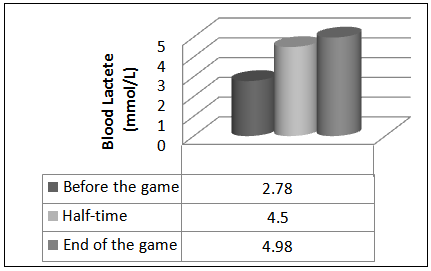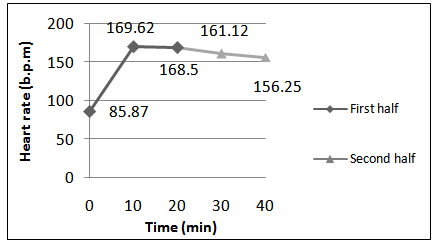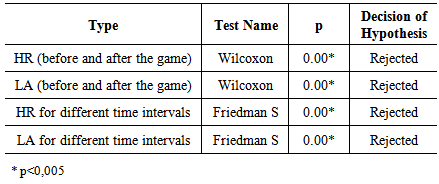-
Paper Information
- Next Paper
- Paper Submission
-
Journal Information
- About This Journal
- Editorial Board
- Current Issue
- Archive
- Author Guidelines
- Contact Us
International Journal of Sports Science
p-ISSN: 2169-8759 e-ISSN: 2169-8791
2014; 4(6A): 71-74
doi:10.5923/s.sports.201401.10
Heart Rate and Lactate Changes in Elite Futsal Players during a Game
Erkal Arslanoğu1, Sümer Alvurdu2, Temel Çakıroğlu3, Ömer Şenel2
1School of Physical Education and Sport, Kafkas University, Kars, Turkey
2School of Physical Education and Sport, Gazi University, Ankara, Turkey
3School of Physical Education and Sport, Karabük University, Karabük, Turkey
Correspondence to: Erkal Arslanoğu, School of Physical Education and Sport, Kafkas University, Kars, Turkey.
| Email: |  |
Copyright © 2014 Scientific & Academic Publishing. All Rights Reserved.
The aim of this study is to determine the changes in heart rate (HR) and lactate levels (LA) in elite futsal players throughout a game. Eight elit futsal players (24±2,8 year, 174,33±4,33 cm, 71,488±3,31 kg, 9,31±2,78 % fat mass) with a mean playing experience of 3,4 years participated in this study voluntarily. Heart rate was recorded for five times at 10 minute intervals (particularly before the start of the game, at the 10th minute, at half-time, at the 30th minute and after the end of the game) using a Polar s610i. Collection of the blood samples from the ear lobe were made before the start of the game, at half-time and after the end of the game. Accutrend Lactate Portable Lactate Analyzer were used to collect blood lactate concentration samples. Non-parametric Wilcoxon Test was used to evaluate heart rate and lactate changes independently before and after the game. For analyzing HR changes in the time intervals of before the start of the game, at the 10th minute, at half-time, at the 30th minute and after the end of the game the Friedman S Test was used for there were more than two groups to analyze. The data are presented as means and standard deviations by using SPSS 17 for Windows and p-values below 0,05 were considered statistically significant. According to the results the HR values and LA levels of the players before and after the game indicate statistically differences, and the HR values and LA levels of the players before the game, at half-time and after the game indicate that at least one of them shows statistically difference from the others. This study demonstrates that heart rate and lactate levels of futsal players were increased linearly (to 4,98 mmol/L from 2,78 mmol/L). Players are exposed to high intensity anaerobic activities during the game because of characteristic features of futsal.
Keywords: Heart rate, Blood lactate, Futsal
Cite this paper: Erkal Arslanoğu, Sümer Alvurdu, Temel Çakıroğlu, Ömer Şenel, Heart Rate and Lactate Changes in Elite Futsal Players during a Game, International Journal of Sports Science, Vol. 4 No. 6A, 2014, pp. 71-74. doi: 10.5923/s.sports.201401.10.
Article Outline
1. Introduction
- Among all indoor soccer versions, FIFA recognizes solely Futsal [1]. “Futebol de Salao” as it is named originally in Portuguese [2], gains growing popularity among the sports lovers in many countries. Spain, Italy, Brazil, Russia and Argentina are the countries where futsal is highly popular. Still, not only these but also all South American countries have flourishing professional futsal leagues.Being an intermittent sport that demands high physical qualities, Futsal comprises of elements of verifying sports from basketball and handball to hockey [3].Though resembling soccer, futsal has its own character by possessing unique features requiring distinct activity profiles and physiological demands, be it the game rules, number and position of the players, or the pitch size [4].By being a sport requiring a smaller game format with less number of players, and bringing physiological and technical/ tactical stimuli together, small-sided games are more demanding on physiology. As a great deal of studies on small-sided games set forth, this kind of a game format causes alterations on physiological variables such as heart rate and blood lactate [5-9].The fact that the reduced pitch dimension and recurrent turnovers force futsal players to develop fast decision-making and high sprint capabilities in coping with the pressure during attacking and defending phases is demonstrative of this situation [10].Physical qualities such as reaction, alactic and lactic anaerobic resistance, flexibility and speed are vital for futsal players who are to perform in a small playing area at a high intensity [11-13].The aim of this study is to determine the changes in heart rate and lactate levels in elite futsal players during a friendly match with official rules.
2. Methods
2.1. Subjects
- Eight elite futsal player from TÜFAD Ankara Futsal Team representing Turkey in the preliminary round of UEFA Futsal Cup 2012 participated in this study voluntarily.
2.2. Procedure
- The players who attended the study performed a friendly match with official rules. The players were informed about the aims, method, prospective contributions of the study. Players were also provided with full information about possible risks they may face during the study and signed a consent form. All measurements were taken during the game.
2.3. Heart Rate and Blood Lactate
- Heart rate was recorded for five times at 10 minute intervals (particularly before the start of the game, at the 10th minute, at half-time, at the 30th minute and after the end of the game) using a Polar s610i. Collection of the blood samples from the ear lobe were made before the start of the game, at half-time and after the end of the game. Accutrend Lactate Portable Lactate Analyzer was used to collect blood lactate concentration samples. Goalkeepers were not taken into consideration.
2.4. Statistical Analyses
- Due to the lack of data with a normal distribution, non-parametric Wilcoxon Test was used to evaluate heart rate and lactate changes independently before and after the game. Two hypotheses were determined in this study: H0 : The difference between the medians of the two groups is zero.H1 : The difference between the medians of the two groups is different from zero.For analyzing HR changes in the time intervals of before the start of the game, at the 10th minute, at half-time, at the 30th minute and after the end of the game the Friedman S Test was used for there were more than two groups to analyze.
 null hypothesis;
null hypothesis; at least one of them shows difference from the others.The null hypothesis (H0) was tested against the alternative hypothesis (H1) The data are presented as means and standard deviations by using SPSS 17 for Windows and p-values below 0,05 were considered statistically significant.
at least one of them shows difference from the others.The null hypothesis (H0) was tested against the alternative hypothesis (H1) The data are presented as means and standard deviations by using SPSS 17 for Windows and p-values below 0,05 were considered statistically significant.3. Results
3.1. Players’ Profile
- Players’ age, height, body mass, and futsal playing experience are 24±2,8 year, 174,33±4,33 cm, 71,488±3,31 kg, and 3,4 years, respectively.
|
3.2. Heart Rate
- Heart rate values (b.p.m) of futsal players before the start of the game, at the 10th minute, at half-time, at the 30th minute and after the end of the game are shown in figure 1.
 | Figure 2. Lactate changes of futsal players during the game |
3.3. Heart Rate and Lactate Levels for Different Game Periods
- According to the results of Wilcoxon Test analysis for HR and LA, p-values were obtained as 0,00. When the results are examined at the α=0,05 level of meaning, since p<α, the H0 null hypothesis was rejected. That is to say, the HR values and LA levels of the players before and after the game indicate differences (Table 2).In the Friedman S Test analysis for HR and LA, p-values were obtained as 0,00. When the results are examined at the α=0,05 level of meaning, since p<α, the H0 null hypothesis was rejected. That means, the HR values and LA levels of the players before the game, at half-time and after the game indicate that at least one of them shows difference from the others (Table 2).
|
4. Discussion
- In this study, changes in the heart rate and lactate levels were determined. Results showed that the average maximum heart rate level was reached at the end of the 10th minute (169,62 beat/min.), while the minimum heart rate level was seen at the end of the match (156,25 beat/min.). The examination of the lactate levels demonstrated that the lactate level measured before the match that was 2,78 mmol/L, rised to 4,5 mmol/L at the half-time, and to 4,98 mmol/L at the end of the game.Available research has demonstrated that Futsal is a multiple-sprint sport in which high-intensity exercise constitutes a greater proportion of match time than in all other team sports. The results indicate a greater proportion of time spent above 85% of maximum heart rate (HRmax) with mean values of 90% HRmax per match. Under more specific analysis, only 0.3% of playing time is spent in low activity (below 65% of HRmax), 16% in moderate activity (between 65-85% of HRmax), and 83% in very vigorous activity (above 85% of HRmax) These cardiovascular demands demonstrate the primordial role of the anaerobic metabolism which in most players is above the lactate threshold [2].In a study [14] in which eight elite futsal player (age 22.4 years, body mass 75.4 kg, height 1.77) attended physiological measurements were assessed during highly competitive training games (4x10-min quarters) and consisted of game blood-lactate concentration and game heart rates. They found that, during simulated match, peak game VO2 and HRs were 99% (88-109) and 98% [90-106], respectively. Mean lactate value was 5.3 mmol.Despite there was a similarity between the physical characteristics of the sample groups of the above mentioned and our study, the end of game avarage lactate level this previous study obtained (5,3 mmol) was greater than the findings of our study (4,98 mmol).In another study [3] where four futsal matches were analyzed changing heart rates of the players were assessed. Heart rates of eight futsal players (mean age 25.6 years, body mass 73.8 kg, height 1.75 m) were monitored during the matches. According to the findings of that study, mean heart rate during the match was 90% of maximum heart rate. Heart rate records classified in three zones (>85%, 85-65%, and <65% maximum heart rate); players spent 83%, 16%, and 0.3% in these three zones, respectively.Studies evaluating match demands of futsal demonstrated that players spent more than 50% of the playing time at exercise intensities higher than 90% of maximum HR (HRmax) and blood lactate concentration increased after physical stimulation, reaching average values of 5.3 mmol/L [14]. These data suggest that futsal games demand high physical effort energetically sustained mainly by anaerobic metabolism.In a 2005 study by Pagano, et. al., physiological and hormonal aspects of futsal players were analyzed. No significant difference was found for the percentages of occurrence of %HRmax during the two halves of the futsal matches and for LA values (warm up: 2.0 ± 0.5 mM; first half: 4.4 ± 2.4 mM; second half: 3.8 ± 2.0 mmol/L). Regarding HR and LA values, the lack of differences between the two halves of the match highlights that players maintain high level of efforts throughout the match [15]. When the results of this study are compared to our findings, the heart rate and lactate levels obtained in this study were seen to be lower than those in our study.In a study [16] whereby physiological data of 30 players of two different competition levels, being 15 elite and 15 college players, were examined, each group was regrouped in itself into 3 teams and played two matches. It is found that the values obtained from the elite group was statically higher (p<0,05) than the values of the amateur group (%HRmax: 89.8±5.8 vs. 86.2±6.7, and blood lactate: 5.5±1.4 vs. 5.1±1.5 mmol/L). The lactate levels of both of the groups analyzed in that study were higher than the results in our study.
5. Conclusions
- In the literature while the exercise intensity that corresponds to 2 mmol/ L lactate concentration is defined as regeneration training, 2-3 mmol/L is defined as intensive endurance, 4-6 mmol/L as extensive interval, and 6-12 mmol/L as intensive interval [17]. This study demonstrates that the lactate level after the game which is measured as 4,98 mmol/L indicates that players are exposed to high intensity anaerobic activities and accordingly that their heart rates and blood lactate levels increased. Concurrently, it can be said that the activity performed in a futsal game is equivalent to the extensive interval trainings.
 Abstract
Abstract Reference
Reference Full-Text PDF
Full-Text PDF Full-text HTML
Full-text HTML

